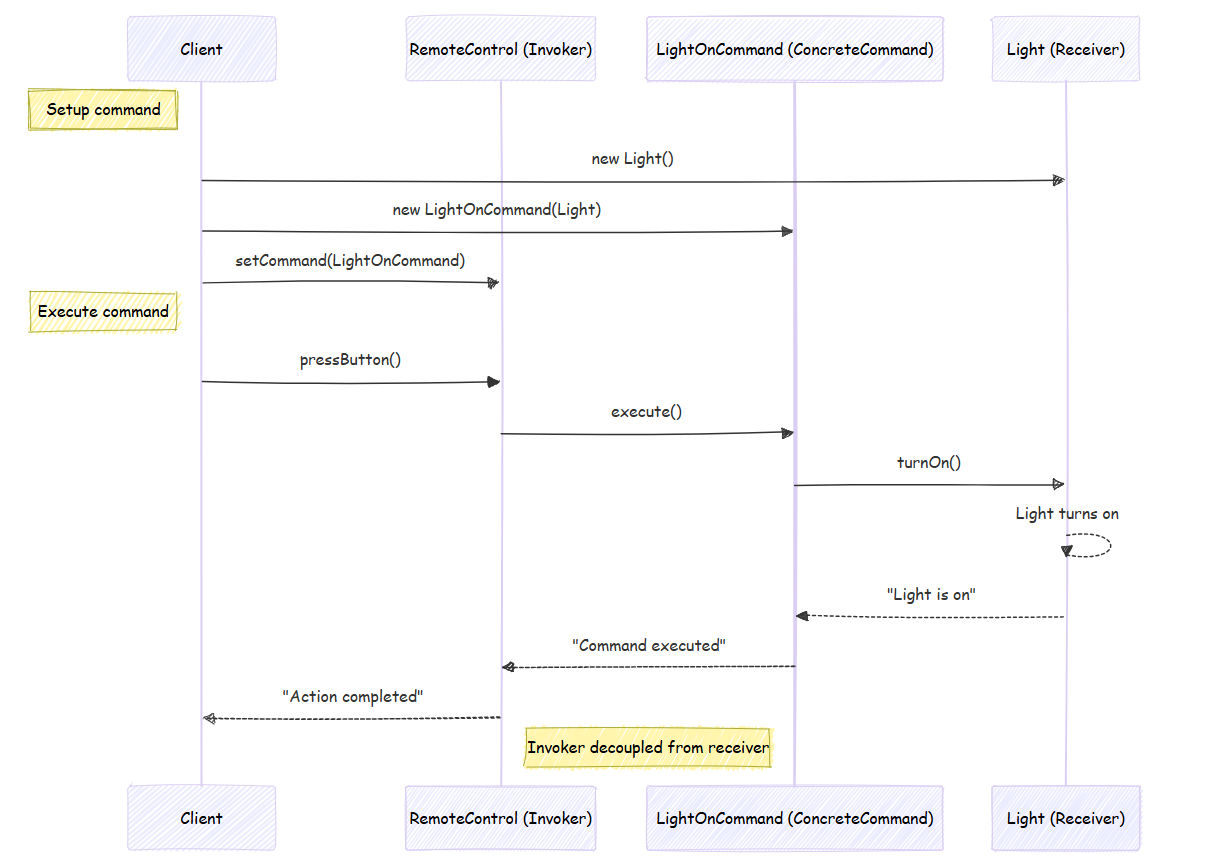Understanding the Command Pattern
The Command Pattern is one of the behavioral design patterns that encapsulates a request as an object, thereby letting you parameterize clients with different requests, queue or log requests, and support undoable operations. Let's dive deep into understanding this powerful pattern and its practical applications.

What is the Command Pattern?
At its core, the Command Pattern decouples the object that invokes the operation from the object that knows how to perform it. It's like a waiter in a restaurant who takes your order (command) and passes it to the chef who knows how to prepare the dish.
Key Components
- Command: An interface or abstract class that declares an execution method.
- ConcreteCommand: Classes that implement the Command interface.
- Invoker: Asks the command to carry out the action.
- Receiver: Knows how to perform the operations.
- Client: Creates the ConcreteCommand and sets its receiver.
Implementation Example
Let's implement a simple example using TypeScript to demonstrate a smart home automation system:
// Command Interface
interface ICommand {
execute(): void;
undo(): void;
}
// Receiver - Smart Light
class SmartLight {
private isOn: boolean = false;
private brightness: number = 0;
turnOn(): void {
this.isOn = true;
console.log('Light is turned on');
}
turnOff(): void {
this.isOn = false;
console.log('Light is turned off');
}
setBrightness(level: number): void {
this.brightness = level;
console.log(`Brightness set to ${level}%`);
}
}
// Concrete Commands
class LightOnCommand implements ICommand {
constructor(private light: SmartLight) {}
execute(): void {
this.light.turnOn();
}
undo(): void {
this.light.turnOff();
}
}
class LightBrightnessCommand implements ICommand {
private previousBrightness: number;
constructor(private light: SmartLight, private brightness: number) {}
execute(): void {
this.light.setBrightness(this.brightness);
}
undo(): void {
this.light.setBrightness(this.previousBrightness);
}
}
// Invoker - Remote Control
class SmartHomeRemote {
private commands: Map<string, ICommand> = new Map();
private commandHistory: ICommand[] = [];
addCommand(buttonName: string, command: ICommand): void {
this.commands.set(buttonName, command);
}
pressButton(buttonName: string): void {
const command = this.commands.get(buttonName);
if (command) {
command.execute();
this.commandHistory.push(command);
}
}
undoLastCommand(): void {
const command = this.commandHistory.pop();
if (command) {
command.undo();
}
}
}
Real-World Applications of the Command Pattern
The Command Pattern finds numerous applications in modern software development:
1. GUI Components
Buttons, menu items, and other UI elements often use commands to separate the UI object from the action it performs. This makes it easy to change the action without modifying the UI code.
2. Transaction Management
Database operations can be encapsulated as commands, allowing for features like:
- Transaction logging
- Rollback operations
- Audit trails
- Retry mechanisms
3. Game Development
Gaming actions like:
- Player movements
- Game state changes
- Replay functionality
- Undo/redo operations
4. Multi-level Undo
Applications like text editors and graphics software use the Command Pattern to implement undo/redo functionality by maintaining a command history.
Benefits of Using Command Pattern
- Decoupling: Separates the object that invokes the operation from the object that performs it.
- Extensibility: New commands can be added without changing existing code.
- Composition: Complex commands can be built from simple ones using the Composite Pattern.
- Undo/Redo: Commands can store state for reversing their effects.
- Deferred Execution: Commands can be serialized and executed later.
Implementation Considerations
When implementing the Command Pattern, consider these best practices:
- Command Validation: Implement validation in commands to ensure they can be executed.
- Error Handling: Include proper error handling in both execute and undo operations.
- State Management: Consider how to handle state for undo operations effectively.
- Performance: Be mindful of memory usage when storing command history.
Code Example: Implementing a Text Editor
Here's a practical example of using the Command Pattern in a text editor:
interface TextEditorCommand {
execute(): void;
undo(): void;
}
class TextEditor {
private content: string = '';
insertText(text: string, position: number): void {
this.content = this.content.slice(0, position) + text + this.content.slice(position);
}
deleteText(start: number, end: number): string {
const deletedText = this.content.slice(start, end);
this.content = this.content.slice(0, start) + this.content.slice(end);
return deletedText;
}
getContent(): string {
return this.content;
}
}
class InsertTextCommand implements TextEditorCommand {
private position: number;
private text: string;
constructor(private editor: TextEditor, text: string, position: number) {
this.text = text;
this.position = position;
}
execute(): void {
this.editor.insertText(this.text, this.position);
}
undo(): void {
this.editor.deleteText(this.position, this.position + this.text.length);
}
}
class TextEditorInvoker {
private commandHistory: TextEditorCommand[] = [];
executeCommand(command: TextEditorCommand): void {
command.execute();
this.commandHistory.push(command);
}
undo(): void {
const command = this.commandHistory.pop();
if (command) {
command.undo();
}
}
}
When to Use the Command Pattern
The Command Pattern is particularly useful when you need to:
- Parameterize objects with operations
- Support undo/redo functionality
- Queue, schedule, or execute operations remotely
- Structure a system around high-level operations
- Support logging and transactional behavior
Common Pitfalls and Solutions
- Overcomplication: Don't use the pattern for simple operations where direct method calls would suffice.
- Memory Leaks: Be careful with command history in long-running applications.
- State Management: Ensure proper state handling for undo operations.
- Performance Impact: Consider using a command pool for frequently used commands.
Conclusion
The Command Pattern is a powerful tool in object-oriented design that provides flexibility and extensibility to your codebase. While it may seem complex at first, its benefits in terms of maintainability, reusability, and functionality make it worth considering for many applications.
Remember that like all design patterns, the Command Pattern should be used judiciously. Consider your specific use case and whether the added complexity is justified by the benefits you'll gain from using the pattern.